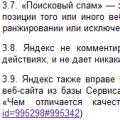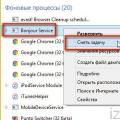Search spam. Search engine spam: what it is, main types and methods of detection
Hello everyone!
Each of us is familiar with the word SPAM. Moreover, everyone has encountered it and seen what it is. For example, in your email, in SMS messages, and almost everywhere. This concept also applies to the search results of Yandex, Google and other systems.
Search spam is sites or pages created for the purpose of manipulating search results. And, as a result, deceiving users and search engines.
Since the ranking of sites in search results is influenced by many factors, manifestations of search spam “put pressure” on them and the web resource quickly takes high positions. Simple re-optimization, in other words.
Basically, on such resources it is impossible to find an answer to a search query, or it is possible, but difficult, but it’s easy to catch a virus or “accidentally” install, for example, Amigo 😀
Types of search spam
There are several obvious manifestations of search spam:
- Oversaturation of text content with keywords;
- Reference "explosion". A sharp increase in the number of external links to the resource;
- Re-optimization of meta tags, ALTs of images;
- A large amount of useless content;
- 100% copying of content from other sites;
- Promotion by behavioral factors.
Each of us can “sin” a little and over-optimize or simply suddenly purchase a large number of external links. All of the above is punished by search engines, usually by exclusion from the index or forced demotion in the search results. So be extremely careful when promoting your resource.
You can read more detailed information about penalties for a particular violation in Yandex.
Special ones are responsible for tracking the actions listed above. For example, if you made a mistake in forming a link mass, then with your own hands you increase the chances of getting into Minusinsk. For example, it is responsible for spamming text.
Once you fall under the filter, it will be very difficult for you to regain the trust of search engines - you can spend a lot of time on this: from a month to several years. Moreover, it is often impossible to return to the previous positions in search results.
To avoid falling under the filter, you just need to follow certain requirements:
- Link only to high-quality resources that are interesting to your visitors;
- Do not abuse too much advertising. Also, you cannot place “shocking” advertising;
- Use external links sparingly. In details ;
- And finally, don’t deceive your visitors.
Other types of search spam
There are other types of search spam that you may also have encountered:
- Doorway sites are web resources that are actively promoted in the search engine in order to automatically redirect traffic to the advertising page of another site;
- Cloaking is pages and sites that provide different content to users and search engine robots in order to influence search engine rankings. In short, the robot sees one thing, and you see something completely different;
- Hidden text. Generating text content that is invisible to visitors, rich in a large number of keywords;
- Clickjacking is the placement of invisible elements on a website, when clicked on, some action occurs;
- Content of malware, viruses. A fairly common occurrence - a person enters , for example, request download driver for wifi modem and ends up on some site where he is asked to download this very driver. But instead of what he was looking for, a virus or some kind of malicious program appears on the computer.
All of the above are severely punished. If you encounter similar manifestations of search spam, feel free to write a complaint to Yandex or Google technical support - it will not go unnoticed.
Search engine spam is the most common tool of so-called “black hat” optimization. Today, search spam is used in one form or another almost everywhere, since, despite the ban on its use for search promotion, with the right approach it can significantly contribute to promotion and increase traffic for a short time.
Moreover, very often novice webmasters use one or another search spam method without even knowing it. For example, buying links is also one of the methods of search spam, but it does not always lead to the imposition of search engine filters on the resource.
There are several basic methods of search engine spam.
Contextual spam. The essence of this method of search spam is to oversaturate the site’s web documents with keywords. The most common way to use contextual spam is to oversaturate the main text of resource pages with a key phrase or word. However, there are more sophisticated ways to use it, including using a font whose color matches the background color for over-optimized text, using a 1-pixel font for keywords, oversaturating web document tags with keywords, and so on.
Today, it is not advisable to use contextual spam, since search algorithms quite effectively detect its use, for which sites fall under filters or are pessimized by search algorithms.
Link spam. This is the most common method of implementing search spam. Its essence lies in unnatural manipulations with the external and internal reference mass of an Internet resource.
Link spam is considered the safest, since the search engine is not always able to accurately determine how exactly a particular site link appeared.
However, excessive use of link spam can lead to serious consequences, including the application of the AGS filter. Therefore, when saturating the link mass with purchased links, you should remember that they must have natural characteristics: be on thematic sites, have various anchors, and so on.
Behavioral spam. This method of search spam is relatively new. Today, search engines are just developing methods to combat behavioral spam, which makes it possible for many optimizers to use it quite effectively.
Cheating the behavioral factors of a website is usually carried out by purchasing activities on exchanges, so its use requires certain financial costs.
SEO spam
Search engines are known to dislike any attempts to influence their algorithms. At the same time, for example, Yandex itself, in its guide for webmasters, describes ways to improve site ranking. It cannot be said about these methods that they lead to manipulation of the search results. But if each of them is slightly strengthened, then the so-called search spam, or spamdexing.
In I have already mentioned some “dark” moments of search engine optimization, which first lead to the rise of the site, and then to its sharp decline or even disappearance.
With search spam it’s about the same, but it cannot be specifically attributed to black hat SEO, because some of his methods only lead to pessimization (deterioration of ranking) of the site and, and not to its complete death. In addition, many webmasters and so-called. SEOs use spamdexing unconsciously (either from a lack of experience, or from an overabundance of it).
Spam on the Internet
It’s probably worth expanding the concept a little spam at all. Initially, the English word "" meant receiving unwanted letters to your email. As a rule, the content of such letters is of a commercial nature with an offer to join some company. Or a classic example - “Give us your personal data so that we can send you $1,000,000.”
Well, over time, all unwanted and unnatural messages (for example, in social network communities and forums) began to be classified as spam. In other words, these are messages with the desire to deceive and gain profit.
What is search spam
It is logical that spamdexing is an attempt to deceive search engines. The license to use the Yandex search engine says:

Yandex definition for spam
Such methods can be classified as very tough, from the field of black SEO - creating doorways, cloaking, hiding text, and softer methods:
- Inclusion in keywords and description meta tags a huge number of keywords and, or words in general Not related to the content of the page (but very popular for search queries). That’s why, by the way, it lost its meaning. Perhaps, at present, incorrect use of Keywords will not lead to negative consequences for the site, but you need to be more careful.
- Oversaturation of texts articles. This clearly hints to search engines about the presence of search spam.
- The same as in the previous paragraph + “pushing” all these words and phrases into accent tags (bold, italics). Directly tells search engines about spamdexing.
- Link spam. Everything here is simple and clear - getting unnatural links to your resource. A good link, from a search engine point of view, should be a recommendation to visit this or that site. And if this site itself tries to get money for itself, and not always in “nice” ways, then it is spamming. Of course, it is practically impossible to push to the TOP (it is possible, but it will take a long time) without external links, so external links must be obtained wisely.
- A new trend in search spam - impact. This is done in several ways: 1) Using programs that emulate user behavior in search results 2) Attracting users so that they, for a fee, will show interest in a site for .
 Search engine spam: what it is, main types and methods of detection
Search engine spam: what it is, main types and methods of detection How to take a screenshot of a page in Google Chrome
How to take a screenshot of a page in Google Chrome How to completely remove apple software update from your computer
How to completely remove apple software update from your computer